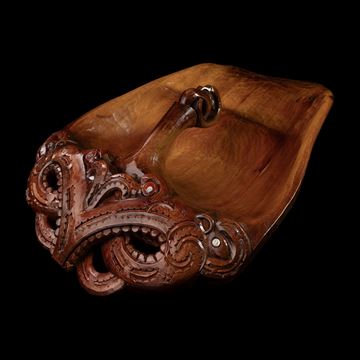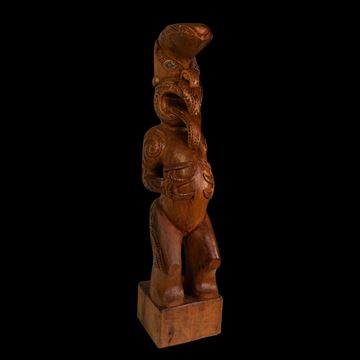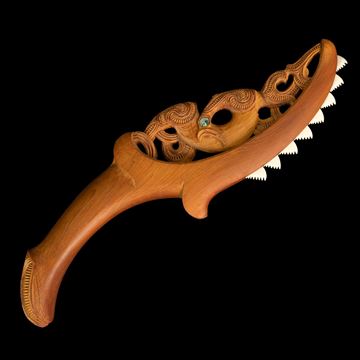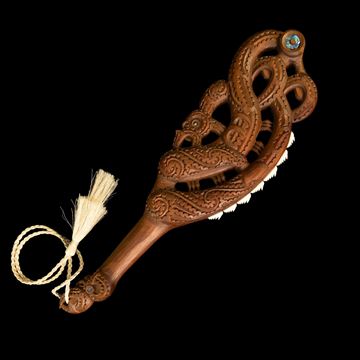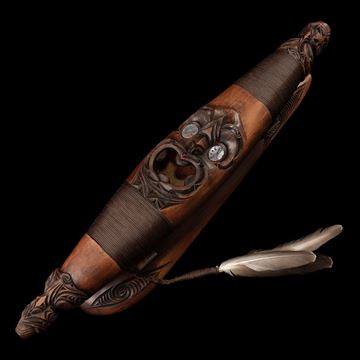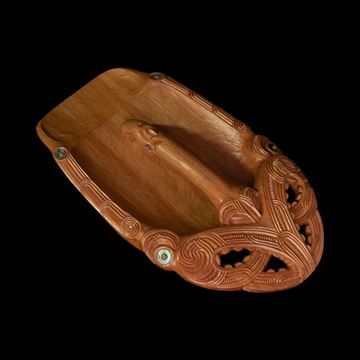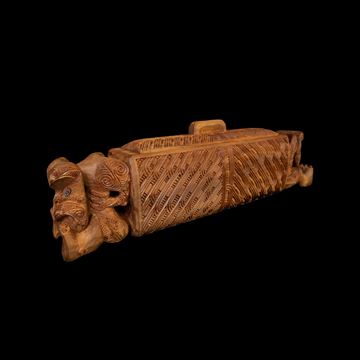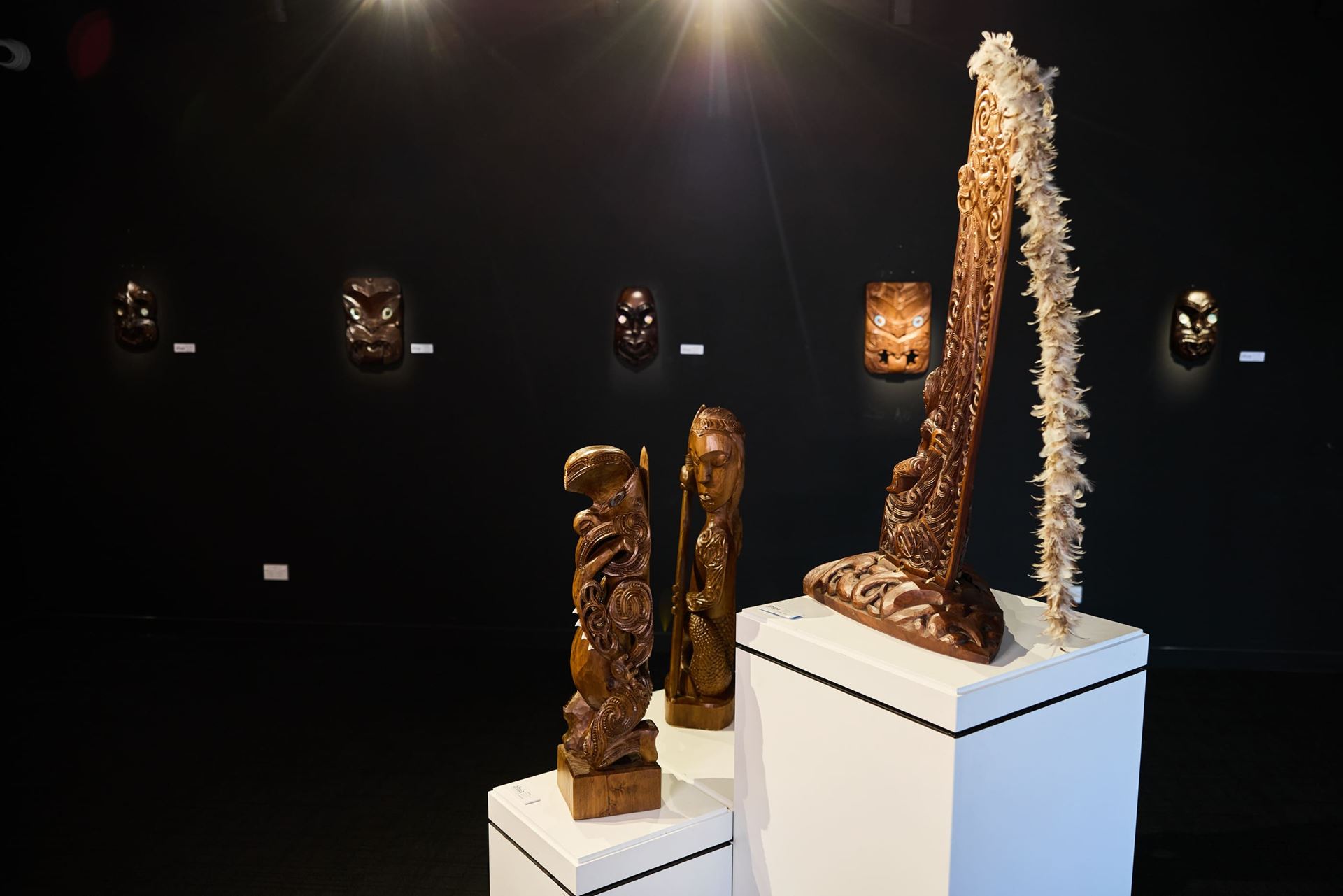
Whakairo Rākau - National Wood Carving School
Since the first intake at Te Wānanga Whakairo, many young Māori from iwi (tribes) throughout New Zealand have been taught the Māori practice of wood carving under the expert guidance of master carvers who were once trainees at the school. This tohu (qualification) is for three years and is 40 hours per week, 47 weeks of the year.
Would you like something custom made just for you? Commission a piece here
Tīheru (Bailer) - 4791TJ
Often the bailer (tatā, tīheru or tā wai) was beautifully carved, and some were given a name. In canoe traditions, tribal members still name the bailers used on the original voyaging canoes from Polynesia.
Material: Tōtara (Red Pine)
Measurements: 270mm x 370mm
$3,900.00
Tekoteko - 4813HG
The tekoteko is a stylised representation of the main progenitor of a tribe and is the most focal point of the whare whakairo (carved tribal meeting house). They can be found – on traditional meeting houses – either at the highest point at the front apex of the roof or at the front central post. They can also be found at the base of the poutokomanawa (the main central ridge support post) of the house.
Material: Tōtara
Measurements: 865mm x 210mm x 180mm
$4,200.00
Māripi - CI2895
Māripi are a traditional meat cutting tool. They are fashioned with a wooden handle and sharks’ teeth carved from Kōiwi (beef bone) to create a serrated edge.
Material: Rātā, Kōiwi (Beef Bone) & Pāua (Abalone)
Measurements: 340mm x 100mm x 30mm
$4,200.00
Māripi - CI2201
Māripi are traditional meat-cutting tools, expertly crafted with a wooden handle and a serrated edge formed from the teeth of a Tuatini or seven-gilled shark. These teeth are carefully shaped and attached to the handle to enhance the tool's cutting effectiveness.
Material: Tōtara, Tuatini Niho (Seven-Gilled Shark Teeth) & Pāua (Abalone)
Measurements: 405mm x 125mm x 40mm
$4,500.00
Pūtōrino (on Stand) - 4799KA
In Māori whakapapa (genealogy), all Māori flutes come to us from Hine Raukatauri, the daughter of Tānemahuta, the atua (spiritual entity) of the forest and birds. Hine Raukatauri is best known as the atua of flute music. She loved her flute so much that she chose to live inside it. She is now personified as the case moth that hangs from branches of trees in a long slender cocoon. This case moth cocoon is where the pūtōrino gets its shape from.
Material: Mataī (NZ Native)
Measurements: 400mm x 70mm x 50mm
$7,990.00
Tīheru (Bailer) - 4793GM
Often the bailer (tatā, tīheru or tā wai) was beautifully carved and some were given a name. In canoe traditions, tribal members still name the bailers used on the original voyaging canoes from Polynesia.
Material: Tōtara
Measurements: 180mm x 300mm x 50mm
$9,900.00
Waka Pungarehu - 2579SL
The Waka Pungarehu (Ash Urn) has two carved tekoteko (statues) positioned at the ends of the waka pungarehu which are carved in the traditional style of whakapakoko, resembling preserved corpses. The surface is intricately adorned with the raperape design, symbolizing the continuous cycle of life and the evolution of death. The pakati and haehae techniques are skillfully carved to enhance the entire waka pungarehu, with the distinctive pakati design known as niho kuri (dog’s teeth) adding a unique touch. The pakati designs feature iroiro (maggots) motifs, symbolizing the natural process of
decomposition when a human body returns to the earth.
Material: Tōtara
Measurements: 450mm x 110mm x 90mm
$10,500.00

